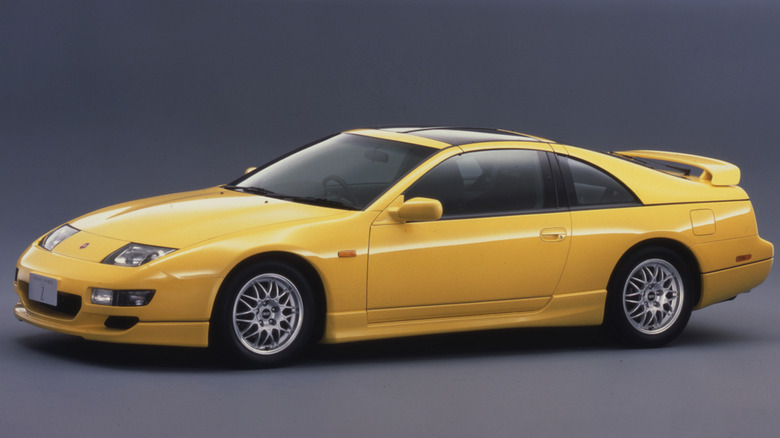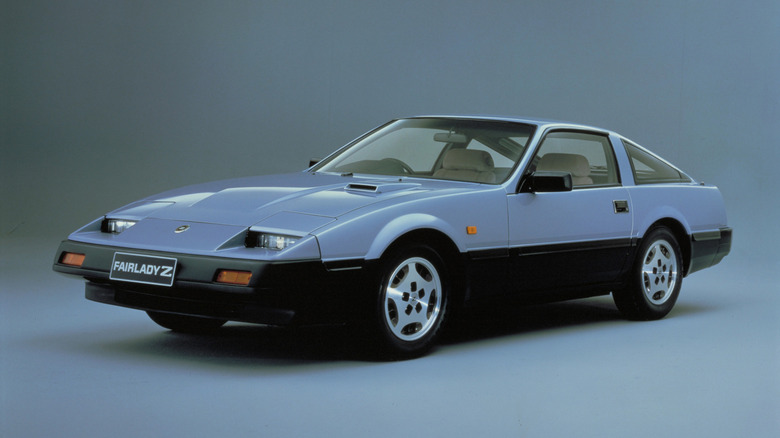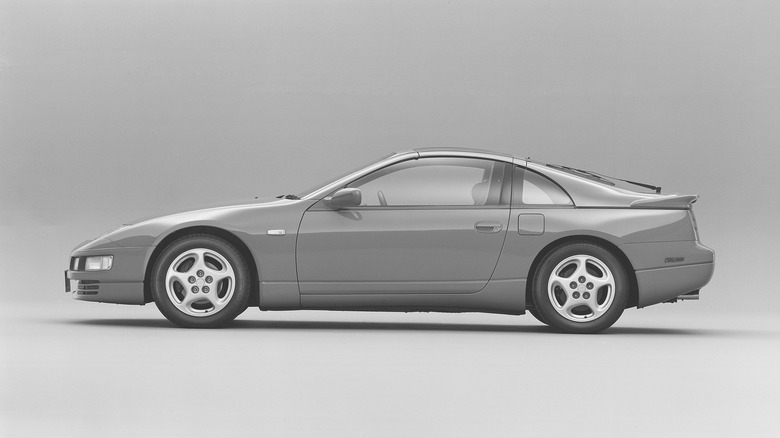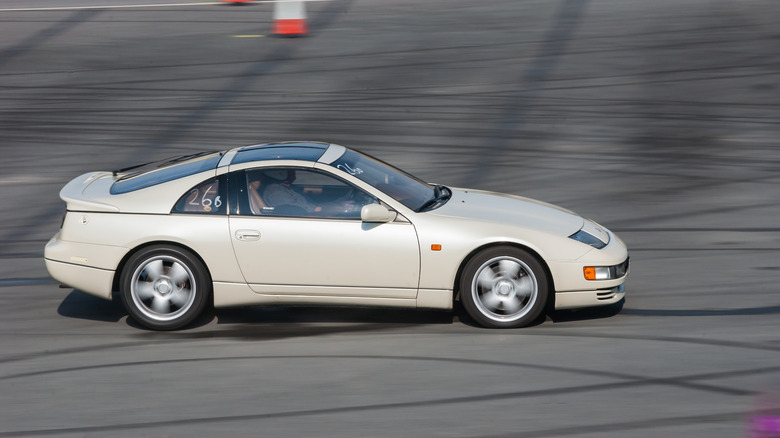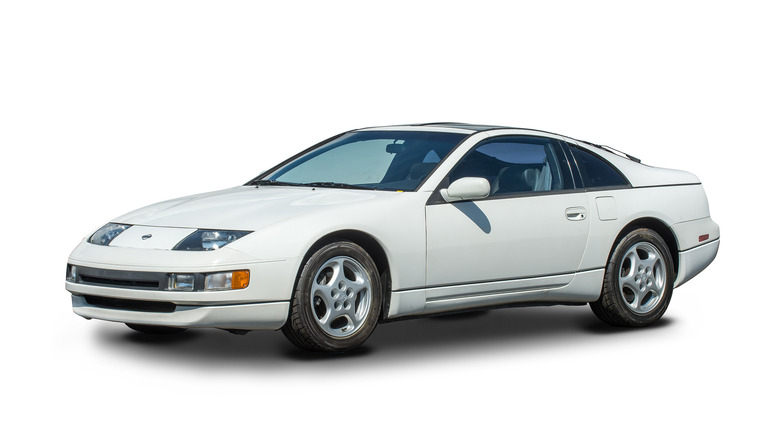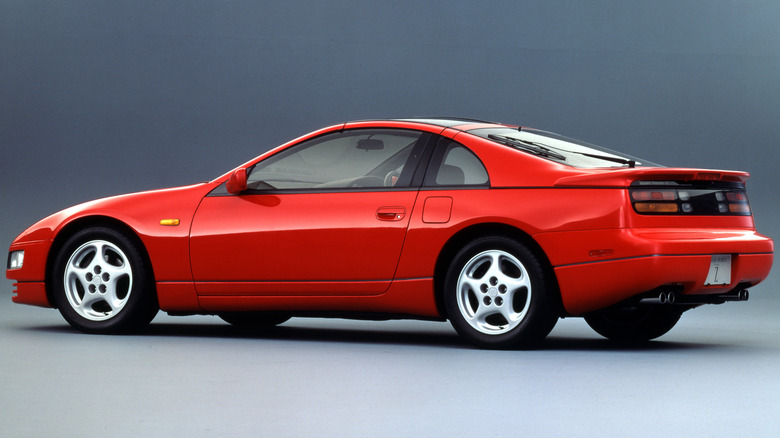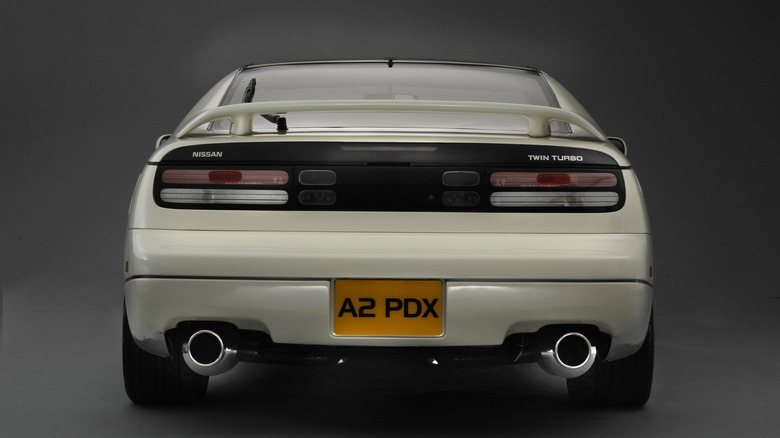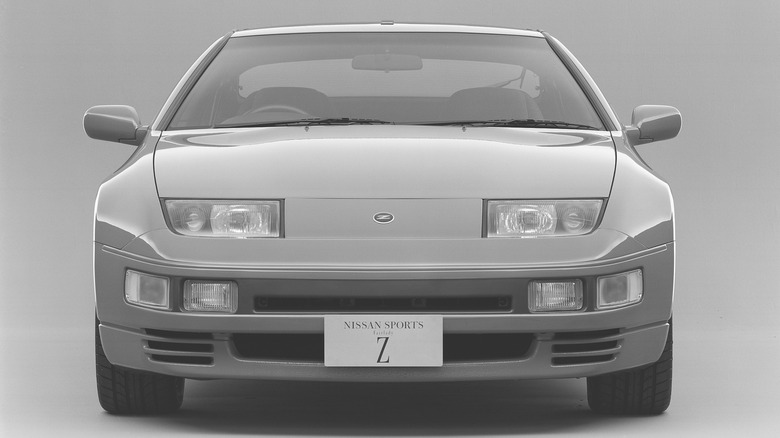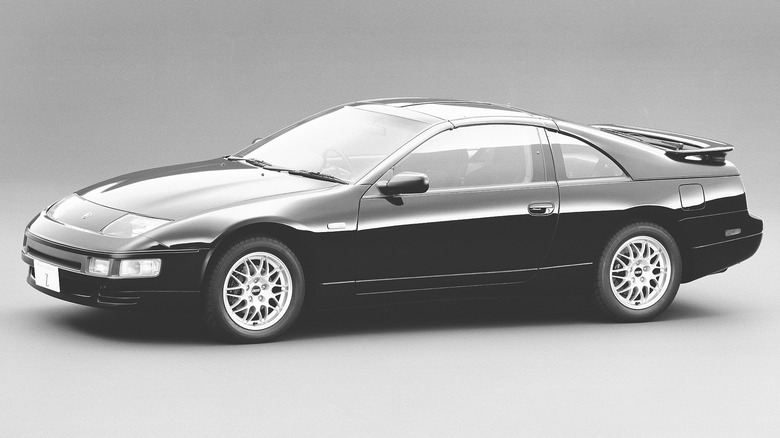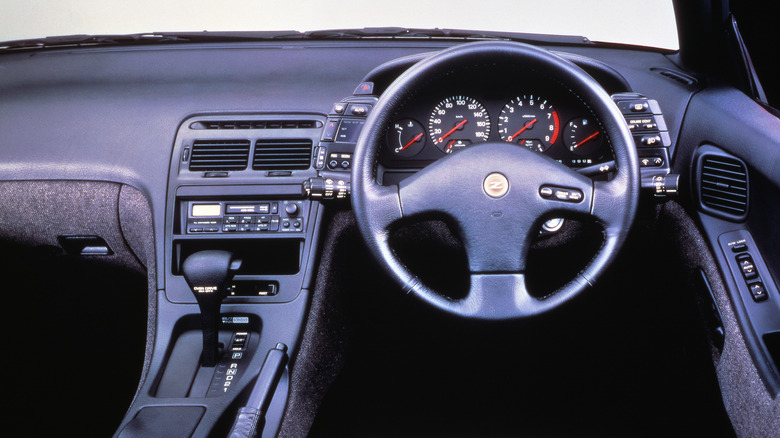9 Of The Coolest And Most Unique Features Of The Nissan 300ZX
By the end of the '80s, Nissan's Z sports car line had an image problem. It had fallen behind its rivals in both design and performance, and a radical change was needed to keep it alive. In 1989, Nissan unveiled the Z32 300ZX, the successor to the uncompetitive Z31. Despite sharing a name, there were very few similarities between the old car and the new — the Z32 was sleeker, faster, and packed with cool features that made it stand out from the crowd.
It was a huge success, and today it's regarded as one of the best Nissans of all time. It's also temptingly cheap to buy on the used market, with prices for potential project cars starting at less than $10,000. However, if you're in the market for a 300ZX, there are plenty of things to know before putting down the cash, not least what makes the car so unique in the first place.
Savior of the Z line
To fully understand why the Z32 300ZX was such a big turnaround for Nissan, it's worth taking a look back at the previous generation Z31. It was, in the eyes of many, a disappointment that strayed away from the formula that made the original 240Z so successful. It was heavier, less precise, and more of a pseudo-sports car than an actual performance car. In an attempt to impress buyers, Nissan also burdened the Z31 with flashy tech like digital displays and spoken warnings and reminders, but most of those extras were seen as more of an annoyance than anything else.
The voice warning system became known as "B**ching Betty," and had quickly fallen out of fashion with buyers, despite being hailed by Nissan as one of the car's most innovative features. The Z31 has seen a slight popularity revival in recent years as a nostalgic classic, but it was considered to be thoroughly outdated at the time it was retired. The Z32 300ZX needed to not only bring the Z line up to par with its contemporary rivals, but it also had to shake off the slightly tacky image of its predecessor. Not an easy task, but one it achieved with such aplomb that it's arguably the reason modern Z cars are still built today.
Computer-aided design
Computer-aided design (or CAD) was still in its infancy at the time of the 300ZX's development, but Nissan's engineers made full use of the technology that was available and designed the car almost completely on CAD. Not only did it fit the futuristic theme Nissan was aiming for with the Z32, but it helped engineers achieve a drag coefficient of just 0.31, making it one of the slipperiest sports cars on the market.
The car's design was one of its biggest selling points, and while styling is always subjective, most would agree that the car has aged well compared to competitors from the era. Its wide, low stance gave it a modern, cutting-edge appeal, even if the wedgy styling influences from the Z31 can still be seen from certain angles. It was, and still is, a unique-looking car, and it's hard to imagine that its rival Japanese manufacturers didn't take at least a little bit of inspiration from its lines when penning their own "golden era" JDM cars that emerged a few years later.
Four-wheel steering
The 300ZX's Super HICAS system is one of the most common points of failure on the car today, and when buying a 300ZX, it's a key indicator of how well the car has been looked after. The reason it's such a headache to keep running is because it's such a unique system, and was very much at the cutting edge of sports car technology at the time of its unveiling. It was offered on Twin Turbo versions only, and could turn the rear wheels a degree or two in either direction based on analysis of the driver's steering input.
Turning the rear wheels in the same direction as the front wheels helped the cornering stability at high speeds, as well as reducing the amount of steering input a driver had to make. Early versions of the car used a hydraulic HICAS system, but an electric system was used from the 1994 model year onwards. In particular, it's the earlier cars that tend to be at the greatest risk of the system failing, although it's something to watch out for on all models. Owners have been known to turn Super HICAS off altogether to avoid the costs of working on it, but in doing so, they're arguably missing out on one of the coolest features the car has to offer.
T-Top roof
It might not be a feature you see on cars anymore, but a T-top still makes a cool addition to any older sports car. The 300ZX's T-top was the most popular option with American buyers, although a hardtop roof (known as a "slicktop") was also available. A convertible was offered in some markets, although few were sold and they're rare to find today. The T-top trend was starting to fade out by the '90s, and the 300ZX was one of the last Japanese cars to offer one. American manufacturers held out the longest, with the Camaro and Trans Am sporting an available T-top up until the early '00s.
The rarity of the slicktop and its lighter weight means that it's the most sought-after option for buyers today, but it's arguably the T-top that's the best period-correct option. However, it can cause some extra headaches for owners — leaking T-top roofs are one of the most commonly reported issues, especially with earlier models, and so if you're on the hunt for a bargain 300ZX with a T-top roof, be sure to check for any signs of water damage in the interior.
Multi-link suspension
Perhaps as a response to criticism about the Z31's wallowing ride, Nissan designed an innovative multi-link suspension for the Z32 300ZX, which aimed to deliver a flatter, sportier feel without compromising on comfort. All four wheels were fitted with multi-link suspension, which at the time was highly unusual for any sports car, as it added a significant amount of extra cost and complexity.
Multi-link suspension also allowed Nissan's development team more freedom to fine-tune the ride than with a traditional suspension setup, keeping the car feeling sharp despite the fact that it was relatively heavy by sports car standards. The rear suspension was derived from Nissan's 240SX sports coupe, but the front suspension was an all-new affair designed specifically for the 300ZX. In the years since the car was unveiled, the multi-link suspension has become more commonplace even in budget-oriented passenger cars, proving the 300ZX to be ahead of its time.
Twin turbochargers
Although the 300ZX could be had in naturally aspirated form, it was the top-spec Twin Turbo that was the pick of the bunch for buyers who could justify spending the cash. The Turbo boasted the fastest 0-60 mph time by a considerable margin, and with 300 horsepower available, it could reach a limited top speed of 155 mph. The idea of using two turbochargers was to ensure a more even power delivery, without the turbo lag associated with earlier turbocharged cars.
It gave the car the poke it needed to fully dispel any lingering stereotypes of being a pseudo-sports car, thrusting it to the top of its segment to compete with the likes of the Chevy Corvette and Porsche 944. Today, the Turbo remains the pricier variant to buy, especially in mint condition — in extreme cases, examples have sold for well over $100,000, although most sell for less than a third of that price.
60-degree slanted headlights
The 300ZX's steeply slanted headlights might not seem unusual today, but at the time, their design was groundbreaking. The lights were the brainchild of Toshio Yamashita, the car's designer, who wanted them to slope at a 60-degree angle to fit the sleek, flowing lines of the rest of the car. He proposed the design to Nissan's engineering department, who initially thought such an angle was unachievable. They tried to convince Yamashita that more traditionally angled or even pop-up headlights would be a better proposition, but he couldn't be swayed, and eventually, engineers found a way to build the original design using small projectors.
The lights were so cutting-edge that, around a decade after the 300ZX's release, Lamborghini actually borrowed them for the Diablo supercar's mid-life facelift. The units used in the Lambo still have Nissan branding on them, which is covered by a carbon fiber piece designed specifically to hide their not-so-exotic origin.
Competitive pricing
Although it was hardly what anyone would call a bargain, when the car first debuted, it was considered great value. In a 1990 test of the 300ZX, Car and Driver concluded, "(W)e can think of no other car that offers more style and [...] beauty for the money," noting that it cost half the price of an Italian supercar, but looked just as good. Performance was also highly impressive, especially with the arrival of the Twin Turbo, which boasted a 0-60 mph time that was only marginally slower than those much pricier supercars.
As the 300ZX has aged and its cutting-edge systems have become obsolete and difficult to work on, plenty of examples have ended up in the hands of owners who are unwilling or unable to keep them in good shape. Used examples can be found for temptingly cheap prices, often significantly less than rivals like the RX-7 and Supra, and that's helped them remain within reach of the average enthusiast even as other Japanese classics have become unattainable. Like any classic car, buyers should always aim to buy the best example they can afford, but that's especially true with the 300ZX — after all, a "bargain" example might start to look like a lot less of a bargain if it needs a lot of costly, complicated work to remedy issues caused by past neglect.
Automatic climate control
It wasn't just the exterior of the 300ZX that wowed buyers, but also the interior, which featured a litany of futuristic touches. One of those was the automatic climate control, which could be set to a specific temperature using the dedicated LCD display, without the need to manually adjust knobs and switches. Looking back, it might not seem too groundbreaking, but in the Nineties, it was an impressive piece of kit.
The Z32 300ZX's big achievement was to embrace technology in a way that didn't feel tacky or counterproductive, as its predecessor had often been labeled. The Z31's talking technology and digital displays were mocked for being annoying and ultimately a bit pointless, but the Z32 took that tech-forward ethos and actually made it beneficial for drivers, rather than simply for show. Over the years, those systems have contributed to the 300ZX's reputation for being difficult to maintain, but at the time, they were a key part of the car's unique appeal.
